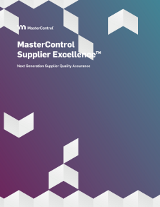
GxP Lifeline
2021 is the Year of Supply Chain Optimization
The accumulative effects of COVID-19 exposed the weak points and fragility of life sciences companies’ supply chains. The pandemic magnified how the occurrence of one vendor-related hiccup in any corner of the world can throw an entire supply chain into disarray. Whether they came in the form of government-enforced cargo restrictions, shutdowns of suppliers’ plants or anything in between, supply chain disruptions that were once considered nuisances became threats to many companies in 2020.
Take the example of the recent availability deterrents to the raw materials and active pharmaceutical ingredients (APIs) on which pharmaceutical companies worldwide depend. It’s estimated that more than 80% of these chemicals used to make drugs are provided by just two countries, China and India.(1) This resulted in significant revenue losses for many pharma manufacturers — especially makers of generic drugs — when those two countries experienced API production delays and plant closures during the pandemic. And subsequent distribution difficulties and other lingering effects have made conditions even more fraught in the wake of the crisis.
These types of challenges have made life sciences companies understandably wary as we enter a new year. Many fear that the more extensive and long lasting the effects of the pandemic are, the more doubts will arise regarding the stability of their supply chains. Now is the time for supply chains to bounce back.
How Resilient is Your Supplier Ecosystem?
The first step to checking the health of your supply chain is to measure risks. According to BCG researchers, the key metrics for gauging the resilience of your supply ecosystem include:
- The degree to which goods are imported.
- The percentage of suppliers concentrated in certain countries.
- The share of supplies that are sourced regionally and are close to end customers.
- The availability of backup suppliers for critical components.
- The inventory levels of key inputs.(2)
A thorough analysis of these metrics should give your organization evidence of source gaps that need to be filled and weaknesses that require reinforcement.
Adaptability in the Face of Adversity
Only the most versatile organizations can thrive in uncertain times. For some life sciences companies, that will mean establishing a local or alternative supplier of components or ingredients. For others, it may require system upgrades to improve supplier communications, relationships and monitoring processes.
The latest research from Gartner indicates that post-pandemic supply chain adaptability will depend on getting the most out of existing technology infrastructures (i.e., cloud and visibility solutions, intranet, instant messaging and transactional systems) that can be elevated with simple extensions and/or implementing new technologies that catalyze versatility. To accelerate recovery from the pandemic’s impacts, Gartner recommends that companies, “Embrace systems and communication portals and/or applications that can help fast-track and establish momentum for a new approach to governing risk across your supply chain.”(3)
Pandemic-level events shouldn’t be the main driver for wanting a resilient supply chain, however. Even if your supplier issues aren’t caused by an unanticipated global crisis, there will always be changes in demand that require some degree of versatility in your supply chain.
3 Steps Toward an Optimized Supply Chain
If your organization has experienced supply chain failures, there are three practical measures you can take to start making improvement.
#1. Pinpoint Your Weakest Links
To identify potential risks and failure points, you must thoroughly evaluate each step of your current supply chain. The stabilization of your supply chain must begin with an objective assessment of the reliability and health of dependent organizations and process dependencies, according to drug supply chain analysis from Ernst & Young.(4)
#2. Make a Backup Plan
Whether or not your organization’s supply chain was significantly affected by COVID-19 repercussions, the events of 2020 alerted everyone to how critical it is to be prepared for supply chain interruptions. If you haven’t already done so, make a risk mitigation plan that assesses the products that could be affected by logistical interruptions, delays or shutdowns experienced by your suppliers and your suppliers’ suppliers. The plan should establish redundancies wherever possible and include alternate (or potential) source opportunities.
#3. Align Quality Across Your Entire Supply Chain
Just as quality is the No.1 priority in production, supplier quality should always be your main focus when it comes to your partners and the products and services they provide. Supplier quality mistakes hit especially hard in the pharma sector where 62% of supply disruption-caused drug shortages are due to product quality and/or manufacturing problems.(4)
If your organization lacks the appropriate infrastructure for effective supplier quality management, it’s time to evaluate technologies that can help you establish a more transparent and collaborative environment. A digitized system with supplier management capabilities and secure access gateways can dramatically enhance interactions with and governance over all your vendors. With the right system, you can centrally manage all supplier-related data, precisely monitor your approved vendor list (AVL) and streamline every aspect of supplier qualification and management.
To learn more about the many ways digitization can enhance control over your supply chain, visit MasterControl’s supplier management solutions page.
References
- “COVID-19 is reshaping the pharmaceutical supply chain,” by Rick Mullin, Chemical & Engineering News, April 27, 2020.
- “Designing Resilience into Global Supply Chains,” Aug. 3, 2020, Boston Consulting Group.
- “The Chief Supply Chain Officers’ Role in Leveraging Technology to Better Recover and Restore Operations Post-COVID-19,” July 27, 2020, Gartner.
- “COVID-19: risks and resiliency in the drug supply chain,” by Alex Jung, Ernst & Young LLP, July 20, 2020.
- “Drug Shortages: Root Causes and Potential Solutions,” 2019 FDA report.

